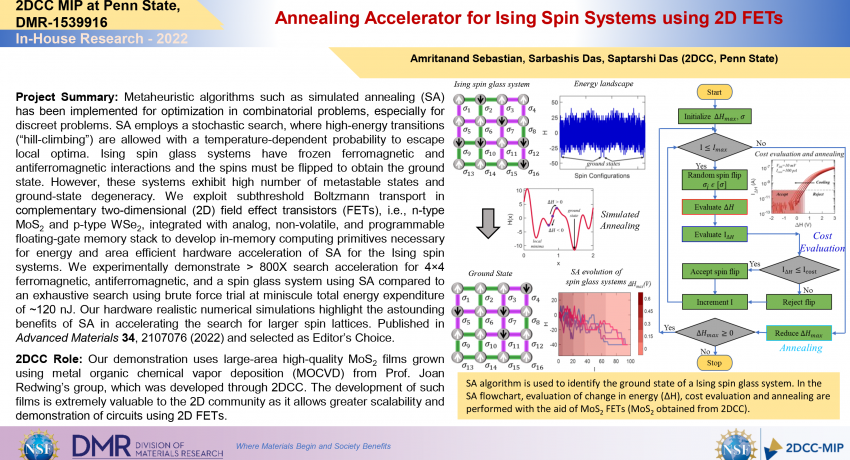What Has Been Achieved:
Demonstration of SA to find the ground states of an Ising spin glass system. We use 2D material-based computing primitives to implement SA in an area- and energy efficient manner. Further, we use in-memory computing to increase the efficiency of this implementation.
Importance of the Achievement:
The development of novel hardware for SA would aid the general field of combinatorial optimization, where finding the optimal solution is extremely time/energy/area consuming without the use of such algorithms and hardware. Hence this could be used to optimize various tasks such as scheduling of transportation, supply chain logistics, and circuit design.
Unique Feature(s) of the MIP that Enabled this Achievement:
Dr. Joan Redwing’s group through 2DCC developed high-quality MoS2 films using MOCVD, which was crucial to our hardware development.
Publication:
Sebastian, A., Das, S., Das, S., An Annealing Accelerator for Ising Spin Systems Based on In-Memory Complementary 2D FETs. Adv. Mater. 2022, 34, 2107076. https://doi.org/10.1002/adma.202107076
The work was supported by Army Research Office (ARO) through Contract Number W911NF1920338. Support for MoS2 growth and characterization at Penn State was provided by the National Science Foundation (NSF) through the Pennsylvania State University 2D Crystal Consortium–Materials Innovation Platform (2DCC-MIP) under NSF cooperative agreement DMR-1539916.
Credits/Names: Amritanand Sebastian, Sarbashis Das, Saptarshi Das (2DCC, Penn State)
Download PDF Version: 1539916_2DCCMIP_2022_Annealing Accelerator for Ising Spin Systems using 2D FETs.pdf
Year of Research Highlight: 2021
Select a Highlight Type: In-House Research Highlight
